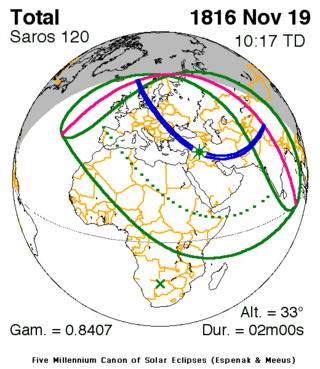Solar eclipse of November 19, 1816
| Solar eclipse of November 19, 1816 | |
|---|---|
 Map | |
| Type of eclipse | |
| Nature | Total |
| Gamma | 0.8408 |
| Magnitude | 1.0233 |
| Maximum eclipse | |
| Duration | 120 sec (2 m 0 s) |
| Coordinates | 35°00′N 41°30′E / 35°N 41.5°E |
| Max. width of band | 144 km (89 mi) |
| Times (UTC) | |
| Greatest eclipse | 10:17:23 |
| References | |
| Saros | 120 (50 of 71) |
| Catalog # (SE5000) | 9081 |
A total solar eclipse occurred on November 19, 1816. A solar eclipse occurs when the Moon passes between Earth and the Sun, thereby totally or partly obscuring the image of the Sun for a viewer on Earth. A total solar eclipse occurs when the Moon's apparent diameter is larger than the Sun's, blocking all direct sunlight, turning day into darkness. Totality occurs in a narrow path across Earth's surface, with the partial solar eclipse visible over a surrounding region thousands of kilometres wide.
Observations
From Germany, this total eclipse could not be seen with clouded sky except by few observers at Pomerania only.[1]
Related eclipses
It is a part of solar Saros 120.
Notes
References
|
- NASA chart graphics
- Googlemap
- NASA Besselian elements
- The 1816 Solar Eclipse and the Comet 1811I in Linnell's Astronomical Album JOURN. HISTORY OF ASTRONOMY V.23, NO. 2/MAY, P.121, 1992

